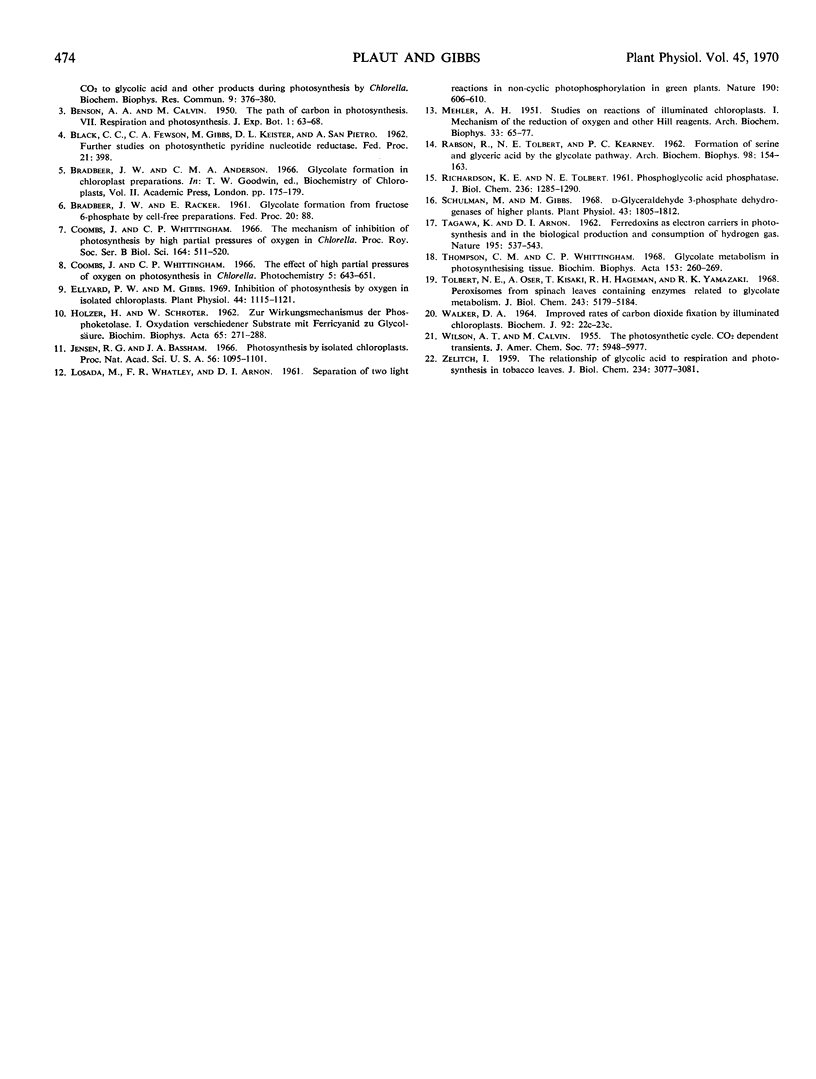Abstract
Photosynthetic 14CO2 fixation and the accumulation of photosynthetic products and the response of each process to both 3-(3,4-dichlorophenyl)-1, 1-dimethylurea (DCMU) and ascorbate were investigated in the intact spinach chloroplast.
Ascorbate increased the rate of CO2 uptake with an increase in all photosynthetic products, but, proportionally, there was a much larger increase in glycolate formation. CO2 fixation inhibited by DCMU was partially restored on addition of ascorbate. Under conditions not optimal for glycolate formation, such as saturating levels of CO2 and an anaerobic atmosphere, ascorbate in the presence of DCMU restored the formation of all photosynthetic products excluding glycolate. This effect of ascorbate on glycolate synthesis in the presence of DCMU was diminished under conditions which favored glycolate formation. Externally added glycerate 3-phosphate and fructose 1,6-diphosphate depressed the appearance of radioactivity in glycolate.
The data are interpreted to indicate that glycolate is produced during photosynthesis as a result of a reaction between a 2-carbon piece derived from a sugar phosphate and an oxidant generated by the photochemical act. The oxidant may be an intermediate of photosystem 2 or a peroxide generated by a mechanism of the Mehler type involving molecular oxygen.
Full text
PDF




Selected References
These references are in PubMed. This may not be the complete list of references from this article.
- Bamberger E. S., Black C. C., Fewson C. A., Gibbs M. Inhibitor Studies on Carbon Dioxide Fixation, Adenosine Triphosphate Formation, & Triphosphopyridine Nucleotide Reduction by Spinach Chloroplasts. Plant Physiol. 1963 Jul;38(4):483–487. doi: 10.1104/pp.38.4.483. [DOI] [PMC free article] [PubMed] [Google Scholar]
- Coombs J., Wittingham C. P. The mechanism of inhibition of photosynthesis by high partial pressures of oxygen in Chlorella. Proc R Soc Lond B Biol Sci. 1966 Apr 19;164(996):511–520. doi: 10.1098/rspb.1966.0046. [DOI] [PubMed] [Google Scholar]
- Ellyard P. W., Gibbs M. Inhibition of photosynthesis by oxygen in isolated spinach chloroplasts. Plant Physiol. 1969 Aug;44(8):1115–1121. doi: 10.1104/pp.44.8.1115. [DOI] [PMC free article] [PubMed] [Google Scholar]
- HOLZER H., SCHROETER W. [On the mechanism of action of phosphoketolase. I. Oxidation of various substrates to glycolic acid with ferricyanide]. Biochim Biophys Acta. 1962 Dec 4;65:271–288. doi: 10.1016/0006-3002(62)91046-6. [DOI] [PubMed] [Google Scholar]
- Jensen R. G., Bassham J. A. Photosynthesis by isolated chloroplasts. Proc Natl Acad Sci U S A. 1966 Oct;56(4):1095–1101. doi: 10.1073/pnas.56.4.1095. [DOI] [PMC free article] [PubMed] [Google Scholar]
- MEHLER A. H. Studies on reactions of illuminated chloroplasts. I. Mechanism of the reduction of oxygen and other Hill reagents. Arch Biochem Biophys. 1951 Aug;33(1):65–77. doi: 10.1016/0003-9861(51)90082-3. [DOI] [PubMed] [Google Scholar]
- RABSON R., TOLBERTNE, KEARNEY P. C. Formation of serine and glyceric acid by the glycolate pathway. Arch Biochem Biophys. 1962 Jul;98:154–163. doi: 10.1016/0003-9861(62)90161-3. [DOI] [PubMed] [Google Scholar]
- RICHARDSON K. E., TOLBERT N. E. Phosphoglycolic acid phosphatase. J Biol Chem. 1961 May;236:1285–1290. [PubMed] [Google Scholar]
- Schulman M. D., Gibbs M. D-glyceraldehyde 3-phosphate dehydrogenases of higher plants. Plant Physiol. 1968 Nov;43(11):1805–1812. doi: 10.1104/pp.43.11.1805. [DOI] [PMC free article] [PubMed] [Google Scholar]
- TAGAWA K., ARNON D. I. Ferredoxins as electron carriers in photosynthesis and in the biological production and consumption of hydrogen gas. Nature. 1962 Aug 11;195:537–543. doi: 10.1038/195537a0. [DOI] [PubMed] [Google Scholar]
- Thompson C. M., Whittingham C. P. Glycollate metabolism in photosynthesising tissue. Biochim Biophys Acta. 1968 Jan 15;153(1):260–269. doi: 10.1016/0005-2728(68)90168-0. [DOI] [PubMed] [Google Scholar]
- Tolbert N. E., Oeser A., Kisaki T., Hageman R. H., Yamazaki R. K. Peroxisomes from spinach leaves containing enzymes related to glycolate metabolism. J Biol Chem. 1968 Oct 10;243(19):5179–5184. [PubMed] [Google Scholar]
- Walker D. A. Improved rates of carbon dioxide fixation by illuminated chloroplasts. Biochem J. 1964 Sep;92(3):22C–23C. doi: 10.1042/bj0920022c. [DOI] [PubMed] [Google Scholar]
- ZELITCH I. The relationship of glycolic acid to respiration and photosynthesis in tobacco leaves. J Biol Chem. 1959 Dec;234:3077–3081. [PubMed] [Google Scholar]


